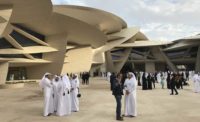The Speed Art Museum in Louisville Announces Plans for Sculpture-Studded Public Green Space






The museum—located on the University of Louisville’s Belknap campus—announced today that this initiative, called The Speed Outdoors and designed by Reed Hilderbrand Landscape Architecture, will feature 13 large-scale contemporary pieces from its growing collection of outdoor sculptures. Populating the new garden will be works by artists and designers including Zaha Hadid, Sol LeWitt, Deborah Butterfield, and Los Angeles–based designer Kulapat Yantrasast, whose multidisciplinary architecture firm, WHY, led a major renovation and expansion of the Speed that debuted in 2016. That $50 million, four-year project included the new boxy North Pavilion and nearly tripled the institution’s exhibition space.
Addressing the enduring need for public green space in central Louisville, the revamped museum grounds will be free and open to the public at all hours, and are expected to receive up to 500,000 visitors annually, including UofL students and faculty. Per an announcement, the new scheme will promote relaxation and recreation through year-round programming that consists of concerts, yoga classes, meditation, and outdoor learning activities.

Rendering of the Speed Outdoors community park. Image courtesy Reed Hilderbrand Landscape Architecture
Lopa Mehrotra, chair of the Speed’s Board of Trustees, described the new sculpture garden in a statement as a “pivotal opportunity for the Speed to expand its impact as a cultural hub of Louisville, continuing to respond to the community’s needs and providing something truly transformative for the region.”
The park was designed in partnership with arborists and native plant experts, and will incorporate “pollinator-friendly native flora, a revitalized shade canopy created by planting at least 150 native trees, and advanced water management systems.”
The Speed Outdoors was developed by the museum, a privately owned nonprofit institution, in coordination with the university, which is part of Kentucky’s public state university system. The Speed was originally founded in 1925 by Hattie Bishop Speed as a memorial to her late husband James Breckenridge Speed, a noted industrialist and philanthropist. In 1927, this establishment first opened the doors of its austere limestone >Beaux-Arts edifice by local architect Arthur Loomis to the public. Prior to the WHY-led expansion and renovation project, additions to the original building were carried out in 1954, 1983, and 1999.

1

2

3
Works on view at the future sculpture park will include Progression (1997) by Sol LeWitt (1), Pair of Chairs (2012) by Kulapat Yantrasast exterior (2) and Bench (2003) by Zaha Hadid (3). Photos courtesy the Speed Art Museum
The Speed Outdoors marks the latest effort in Cambridge, Massachusetts, and New Haven–based Reed Hilderbrand’s extensive portfolio of museum-adjacent interventions. Perhaps most notably, the firm previously designed the Crystal Bridges Museum of American Art’s grounds in Bentonville, Arkansas (2005–11); renovated 85,000 square feet of Manhattan’s Theodore Roosevelt Park in conjunction with the American Museum of Natural History’s new Gilder Center (2015–23), and created a master plan for Alamo Plaza in San Antonio (ongoing since 2017).
Construction of The Speed Outdoors is ongoing and expected to conclude in late 2025. The museum has initiated a $22 million capital campaign to fund construction, ongoing maintenance, and programmatic support.
“The Speed Outdoors represents our vision for a museum shaped by dedication to inclusivity, belonging, and boundless forms of creativity,” said Raphaela Platow, the museum’s director. “Paying homage to the Olmsted brothers’ dream of a Louisville connected by public parklands and emphasizing the restorative potential of accessible green space, it will serve as a welcoming forum for the whole community to connect with art, nature, and each other for generations to come.”







